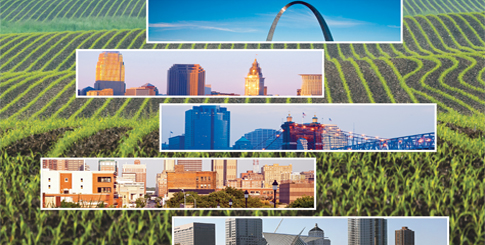Among the top crops harvested from midwestern fields are sweet corn, watermelon, potatoes, onions, pumpkins, apples, and more. Sweet corn is available and sourced locally in all six of the metro areas. Melons from Indiana and Missouri are regional mainstays; so are Wisconsin potatoes and cabbage, and onions from Iowa and Minnesota.
Receivers also report small, but significant, apple volumes from Iowa and Missouri, though nearby Michigan is king in the region. Then there are pumpkins—the Midwest leads production in pumpkins, and there are also several varieties of squash.
Much of what’s in the fields corresponds to demand and price. “Growers here, like everywhere else, respond to price. So it’s pretty much a guarantee if prices are up for a crop one year, they’ll plant more acres of that crop the next,” confirms Don Goetz, president of Fries Brothers, Inc., in Cincinnati.
L is for ‘Local’
Similar to most other regions of the country, the local craze is still going strong with many Midwest growers stepping up to meet demand. Consumers in Ohio, Indiana, and northern Kentucky are very interested in buying local produce, according to Goetz. The same desire to source locally persists in foodservice as well. “It seems like every chef still wants something that’s been grown in their backyard,” he notes.
But while the trend toward local continues, food safety certifications are heating up, crimping smaller growers who are unable or unwilling to meet retailer or foodservice sourcing criteria. Like other receivers in the region, Goetz sees longer-term sourcing trends favoring the region’s larger grower-shippers and others meeting food safety requirements for wholesale.
“The challenge is two-fold with local sourcing,” summarizes Maglio. “First, we have to meet the consumers ‘definition’ of local: how many miles, counties, or states are within that area? Second, do the growers meet the criteria for food safety and risk management? Finding the exact combination that works is a time consuming, case-by-case operation.”
There are also two other challenges inherent to sourcing from the region: an agricultural infrastructure that has yet to fully support the trend, as some areas lack the necessary packing and storing facilities to keep up with volume, and the Midwest’s famously variable weather. “Weather is always a challenge at the shipping end for sourcing in the Midwest,” confirms Parr.
G is for Greenhouses
One way to increase volume and skirt the Midwest’s unpredictable weather, as well as crop pest and disease pressure, is a physical, protective barrier. Regional vegetable growers continue to invest in greenhouses to protect crops and assure quality. Greenhouse operators, large and small, are expanding and selling to wholesalers, retailers, restaurants, farmers’ markets, and CSAs.



